A) House Depot's producer surplus would increase by $4.
B) Lace Hardware Hardware's producer surplus would increase by $3.
C) Bob's Hardware's producer surplus would remain unchanged.
D) All of these statements are true.
F) B) and C)
Correct Answer

verified
Correct Answer
verified
Multiple Choice
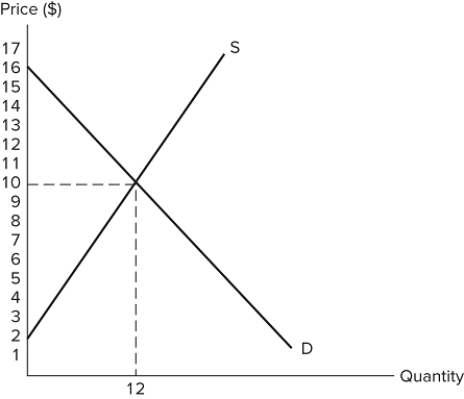 Assume the market depicted in the graph is in equilibrium. What is consumer surplus?
Assume the market depicted in the graph is in equilibrium. What is consumer surplus?
A) $36
B) $72
C) $120
D) $60
F) A) and C)
Correct Answer

verified
Correct Answer
verified
Multiple Choice
A seller's willingness to sell:
A) is the maximum price that a seller is willing to accept in exchange for a good or service.
B) is the minimum price that a seller is willing to accept in exchange for a good or service.
C) is always greater than a buyer's willingness to pay.
D) must always equal a buyer's willingness to buy.
F) A) and B)
Correct Answer

verified
Correct Answer
verified
Multiple Choice
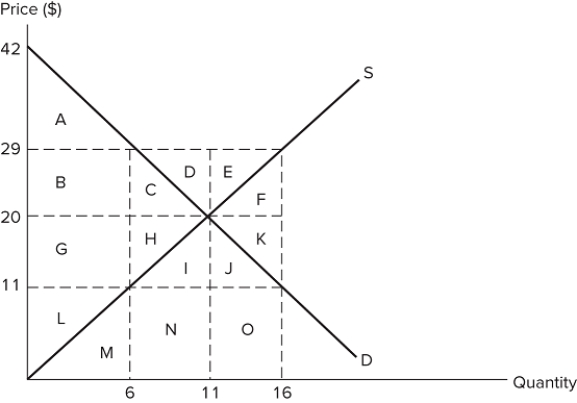 If price is set at $11 in the market shown in the graph, consumer surplus will consist of areas:
If price is set at $11 in the market shown in the graph, consumer surplus will consist of areas:
A) A + B + G.
B) B + G + L
C) A + B + C + G + H + L
D) A + B + C + G + H + I + J
F) None of the above
Correct Answer

verified
Correct Answer
verified
Multiple Choice
A market has four individuals, each considering buying a grill. Assume that grills come in only one size and model. Martina considers herself a grill-master, and finds a grill a necessity, so she is willing to pay $400 for a grill. Javier is a meat-lover, honing his grilling skills, and is willing to pay $350 for a grill. Kamal wants to impress his friends with his vegetable grilling skills and is willing to pay $320 for a grill. Lina loves grilled shrimp and thinks it might be cheaper in the long run if she grills her own shrimp instead of eating out at a restaurant, so she is willing to pay $200 for a grill.If the market price of grills is $320, what is Martina's consumer surplus?
A) $400
B) $350
C) $320
D) $80
F) A) and C)
Correct Answer

verified
Correct Answer
verified
Multiple Choice
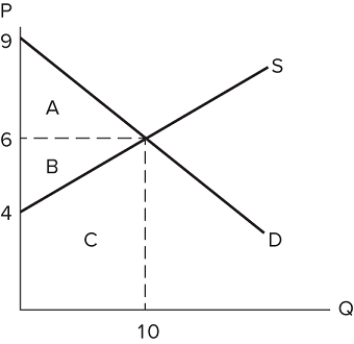 Assume the market depicted in the graph is in equilibrium. If the price is set below $6:
Assume the market depicted in the graph is in equilibrium. If the price is set below $6:
A) producer surplus will increase.
B) producer surplus will decrease.
C) total surplus will increase.
D) quantity will increase.
F) A) and D)
Correct Answer

verified
Correct Answer
verified
Multiple Choice
The concept of surplus can show:
A) the benefits of introducing new markets.
B) who benefits from a tax.
C) who loses from minimum wage.
D) All of these are correct.
F) B) and C)
Correct Answer

verified
Correct Answer
verified
Multiple Choice
A buyer always wants to pay a price that is as _____ as possible, but never _____ than the buyer's willingness to pay.
A) high; higher
B) low; lower
C) low; higher
D) high; lower
F) A) and B)
Correct Answer

verified
Correct Answer
verified
Multiple Choice
Suppose the market for kidneys is depicted in the graph shown. 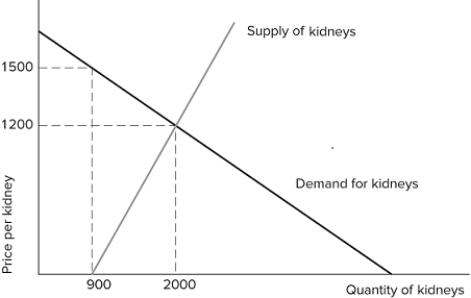 Kidneys can only be donated and cannot be sold (meaning price is zero) . How many kidneys are donated in this hypothetical situation?
Kidneys can only be donated and cannot be sold (meaning price is zero) . How many kidneys are donated in this hypothetical situation?
A) 0
B) 900
C) 2,000
D) 1,200
F) All of the above
Correct Answer

verified
Correct Answer
verified
Multiple Choice
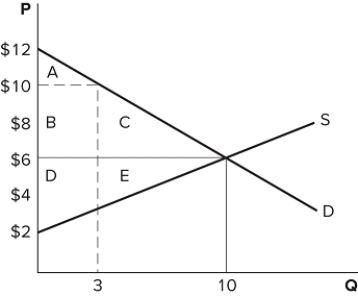 According to the graph shown, if the market goes from equilibrium to having its price set at $10:
According to the graph shown, if the market goes from equilibrium to having its price set at $10:
A) area (C + E) becomes deadweight loss.
B) area (B) transfers from consumer surplus to producer surplus.
C) $12 of surplus transfers from consumers to producers.
D) All of these are correct.
F) A) and B)
Correct Answer

verified
Correct Answer
verified
Multiple Choice
Suppose Takumi's willingness to pay for one snowboard is $250 and his willingness to pay for a second snowboard is $400. How many snowboards would Takumi buy if the market price of snowboards is $500?
A) 0
B) 1
C) 2
D) The amount of snowboards purchased would depend on Takumi's income.
F) A) and D)
Correct Answer

verified
Correct Answer
verified
Multiple Choice
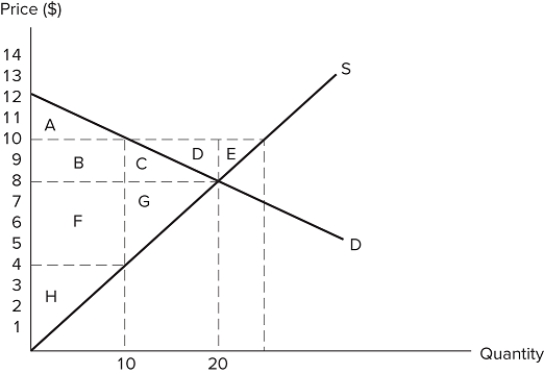 According to the graph shown, if the market goes from equilibrium to having its price set at $10:
According to the graph shown, if the market goes from equilibrium to having its price set at $10:
A) total surplus will fall by $30.
B) producer surplus will rise by $45.
C) total surplus will change by $15.
D) consumer surplus will fall by $30.
F) A) and C)
Correct Answer

verified
Correct Answer
verified
Multiple Choice
Assume there are three hardware stores, each willing to sell one standard model hammer in a given time period. House Depot could offer a hammer for a minimum of $7. Lace Hardware could offer a hammer for a minimum of $10. Bob's Hardware could offer a hammer for a minimum of $13.If the market price of hammers increased from $8 to $11, total producer surplus would increase by:
A) $3.
B) $6.
C) $9.
D) $4.
F) B) and C)
Correct Answer

verified
Correct Answer
verified
Multiple Choice
Suppose the market for kidneys is depicted in the graph shown. 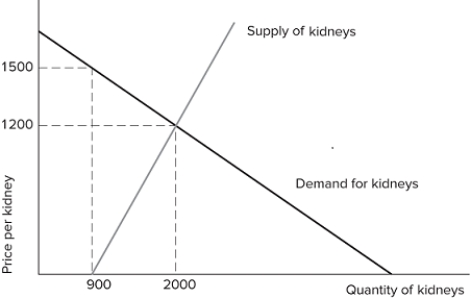 Initially, kidneys exchanges are regulated to allow donations only. This means kidneys can only be exchanged at a price of zero. What is the deadweight loss from this restriction?
Initially, kidneys exchanges are regulated to allow donations only. This means kidneys can only be exchanged at a price of zero. What is the deadweight loss from this restriction?
A) $0
B) $825,000
C) $1,350,000
D) $1,500,000
F) B) and D)
Correct Answer

verified
Correct Answer
verified
Multiple Choice
Suppose Sally purchases a pair of shoes for $45. Which of the following prices could represent Sally's willingness to pay for a pair of shoes?
A) $15.00
B) $25.00
C) $44.99
D) $55.00
F) B) and C)
Correct Answer

verified
Correct Answer
verified
Multiple Choice
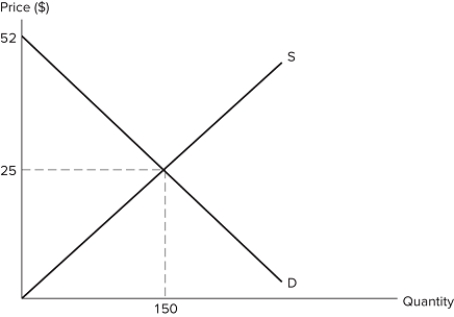 Assume the market depicted in the graph is in equilibrium. If the price is subsequently set at $28, which of the following statements is true? I. Some producers will gain surplus.
II) All consumers will lose surplus.
III) Total surplus may increase or decrease.
Assume the market depicted in the graph is in equilibrium. If the price is subsequently set at $28, which of the following statements is true? I. Some producers will gain surplus.
II) All consumers will lose surplus.
III) Total surplus may increase or decrease.
A) III only
B) I and III only
C) I and II only
D) I, II, and III
F) A) and C)
Correct Answer

verified
Correct Answer
verified
Multiple Choice
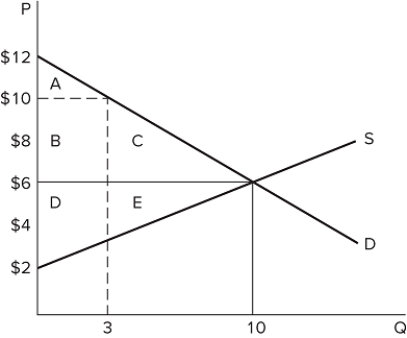 Assume the market depicted in the graph is in equilibrium. Total surplus consists of area(s) :
Assume the market depicted in the graph is in equilibrium. Total surplus consists of area(s) :
A) A.
B) A + B + C.
C) A + B + C + D + E.
D) D + E.
F) None of the above
Correct Answer

verified
Correct Answer
verified
Multiple Choice
Assume there are three hardware stores, each willing to sell one standard model hammer in a given time period. House Depot could offer a hammer for a minimum of $7. Lace Hardware could offer a hammer for a minimum of $10. Bob's Hardware could offer a hammer for a minimum of $13.If the market price of hammers increased from $6 to $7, what would happen to total producer surplus?
A) It would increase.
B) It would remain unchanged.
C) It would decrease.
D) We cannot determine this with the information given.
F) A) and B)
Correct Answer

verified
Correct Answer
verified
Multiple Choice
The demand curve represents consumer's:
A) willingness to pay.
B) trade-offs.
C) surplus.
D) willingness to sell.
F) A) and C)
Correct Answer

verified
Correct Answer
verified
Multiple Choice
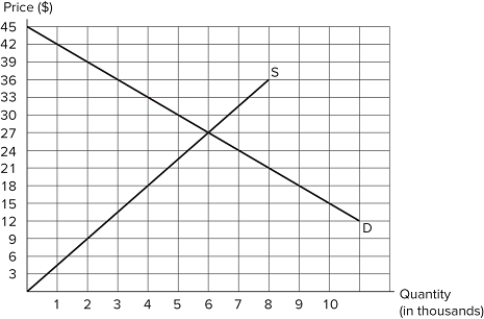 Assume the market depicted in the graph is in equilibrium. If the market goes from equilibrium to having its price set at $18:
Assume the market depicted in the graph is in equilibrium. If the market goes from equilibrium to having its price set at $18:
A) the quantity exchanged will be 9,000.
B) all consumers will gain surplus.
C) the deadweight loss will be $2,250.
D) the quantity exchanged will be 4,000.
F) A) and B)
Correct Answer

verified
Correct Answer
verified
Showing 121 - 140 of 145
Related Exams